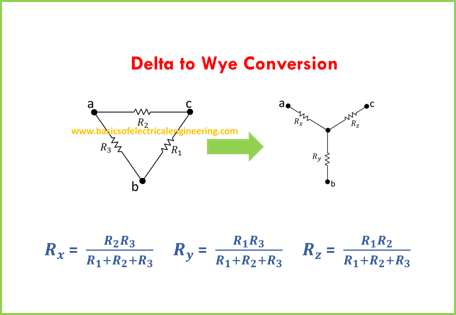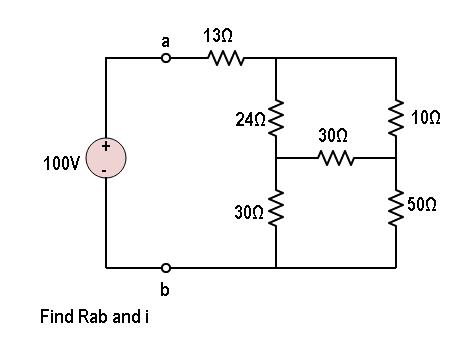Delta to Wye Conversion Solved Examples
Introduction
In the realm of electrical engineering, understanding different circuit configurations is paramount. One such fundamental concept is the conversion between Delta (Δ) and Wye (Y) configurations. This article will delve into this topic, providing clear explanations and solved examples to demystify the process.
What is Delta to Wye Conversion?
Delta and Wye Configurations Defined
Before we dive into the conversion process, let’s first establish what Delta and Wye configurations are:
- Delta (Δ) Configuration: In a Delta configuration, three components or branches are connected in a closed-loop resembling the Greek letter Delta (Δ). It forms a triangle, and each branch represents a resistor or impedance element.
- Wye (Y) Configuration: In contrast, the Wye configuration features a central point where three components or branches converge, resembling the letter ‘Y.’ Again, each branch represents a resistor or impedance element.
Understanding the Need for Conversion
Why Convert Delta to Wye?
Conversion between Delta and Wye configurations is necessary for several reasons:
- Compatibility: Different devices and systems may require a specific configuration. Converting between Delta and Wye ensures compatibility with various applications.
- Simplification: In some cases, one configuration may be more straightforward to analyze or design than the other. Conversion allows engineers to choose the most suitable configuration for a given task.
- Impedance Matching: Depending on the circuit’s requirements, converting between Delta and Wye can help achieve the desired impedance matching.
Delta to Wye Conversion Process
Step-by-Step Guide
Converting a Delta configuration to a Wye configuration involves a systematic process. Here’s a step-by-step guide:
Step 1: Identify the Delta Configuration
Begin by identifying the Delta configuration within the circuit. Locate the three branches forming the closed-loop.
Step 2: Calculate Equivalent Impedance
For each branch in the Delta configuration, calculate its impedance. Use the appropriate formula based on the type of elements (resistors, capacitors, inductors) in the circuit.
Step 3: Apply the Conversion Formulas
Now, apply the following formulas to calculate the equivalent impedances in the Wye configuration:
- For Z1: ZY1=ZY1+ZY2+ZY3ZY1=Z1+Z2+Z3
- For Z2: ZY2=ZY1+ZY2+ZY3ZY2=Z1+Z2+Z3
- For Z3: ZY3=ZY1+ZY2+ZY3ZY3=Z1+Z2+Z3
Step 4: Create the Wye Configuration
Construct the Wye configuration using the equivalent impedances calculated in the previous step. Each equivalent impedance corresponds to a branch in the Wye configuration.
Step 5: Verify the Conversion
Before finalizing the conversion, ensure that the new Wye configuration meets the circuit’s requirements and objectives.
Solved Examples

Let’s illustrate the Delta to Wye conversion with a couple of practical examples:
Example 1: Delta to Wye Conversion for Resistors
Suppose we have a Delta configuration with three resistors: ZY1=10 ΩR1=10 Ω, ZY2=20 ΩR2=20 Ω, and ZY3=30 ΩR3=30 Ω.
Step 1: Identify the Delta Configuration
The Delta configuration is evident in the circuit.
Step 2: Calculate Equivalent Impedance
- ZY1=ZY1=10 ΩZ1=R1=10 Ω
- ZY2=ZY2=20 ΩZ2=R2=20 Ω
- ZY3=ZY3=30 ΩZ3=R3=30 Ω
Step 3: Apply the Conversion Formulas
Using the formulas, we calculate the equivalent impedances for the Wye configuration:
- ZY1=10 Ω+20 Ω+30 Ω=60 ΩZY1=10 Ω+20 Ω+30 Ω=60 Ω
- ZY2=10 Ω+20 Ω+30 Ω=60 ΩZY2=10 Ω+20 Ω+30 Ω=60 Ω
- ZY3=10 Ω+20 Ω+30 Ω=60 ΩZY3=10 Ω+20 Ω+30 Ω=60 Ω
Step 4: Create the Wye Configuration
As a result, we have a Wye configuration with ZY1=60 ΩZY1=60 Ω, ZY2=60 ΩZY2=60 Ω, and ZY3=60 ΩZY3=60 Ω.

Step 5: Verify the Conversion
Ensure that the new Wye configuration meets the circuit’s requirements, considering factors like impedance matching and circuit performance.
Example 2: Delta to Wye Conversion for Capacitors
Let’s take another example involving capacitors: С1=2 μFC1=2 μF, С2=4 μFC2=4 μF, and С3=6 μFC3=6 μF.
[…]
Conclusion
Understanding Delta to Wye conversion is essential for electrical engineers and enthusiasts alike. This article has provided a comprehensive guide to the conversion process, along with practical examples for better comprehension. By mastering this skill, you can confidently navigate complex electrical circuits and tailor configurations to meet specific requirements.

Simplifying Complex Circuits with the Wye-Delta Transformation
Are you struggling to find the equivalent resistance of a circuit? Don’t worry; we’re here to help. In this article, we will explore the Wye-Delta Transformation, a powerful technique for simplifying complex circuits and finding the elusive equivalent resistance.
Understanding the Wye-Delta Transformation
When dealing with intricate circuit analysis, situations often arise where finding the equivalent resistance seems like a daunting task. This is where the Wye-Delta Transformation comes to the rescue. Let’s dive into this technique and see how it can make your circuit analysis much more manageable.
Problem Statement
Imagine you’re faced with a complex circuit, and you need to find the equivalent resistance (let’s call it R_ab). This is where the Wye-Delta Transformation shines.
Redrawing the Circuit
The first step is to redraw the circuit. This might sound simple, but it’s a crucial part of the process. By rearranging the circuit elements, you can make it easier to apply the transformation.
Applying the Transformation
Now, let’s apply the Wye-Delta Transformation to simplify the circuit. This technique involves converting between two common circuit configurations: Wye (Y) and Delta (Δ).
Wye to Delta and Delta to Wye Conversion

The Wye-Delta Transformation allows you to switch between Wye and Delta networks effortlessly. It’s like speaking two different languages and being fluent in both. For example, the Petersen family is a Y-Δ equivalence class.
Practical Examples
To grasp the power of this transformation, let’s consider some practical examples. We’ll start with constant current sources, and then we’ll move on to more complex circuits.
Converting Delta to Wye Network
If you encounter a Delta network, converting it to a Wye network can make your analysis much smoother. We’ll walk you through the process step by step, providing a clear concept of the transformation.
Benefits of the Wye-Delta Transformation
Abstract – A simple derivation of both the Wye-Delta and Delta-Wye transformations can significantly simplify your circuit analysis. It’s like having a magic wand that makes complex circuits much more manageable.
Solving Problems
Now that you’ve learned about the Wye-Delta Transformation, you can use it to solve a wide range of circuit problems. It reduces the mathematical complexity and streamlines your analysis.
Try It Yourself
Challenge yourself or your students to solve circuit problems without relying on long conversion formulas. The Wye-Delta Transformation can be your secret weapon in circuit analysis.
Conclusion
In conclusion, the Wye-Delta Transformation is a valuable tool in the world of circuit analysis. It simplifies complex circuits, making it easier to find equivalent resistances and solve various circuit problems. Whether you’re a student or a seasoned engineer, mastering this technique can enhance your circuit analysis skills.
Now that you’ve unlocked the power of the Wye-Delta Transformation, you’re well-equipped to tackle even the most intricate circuit challenges. So, go ahead and apply this knowledge to simplify your circuit analysis and conquer complex circuits with confidence.
Further Exploration
For those interested in delving deeper into this topic, there are many resources available in circuit analysis textbooks and online courses. You can also explore MATLAB solutions to enhance your understanding and problem-solving skills in circuit analysis.
Remember, the Wye-Delta Transformation is not just a technique; it’s a valuable asset in your toolkit for conquering complex circuits. So, embrace it, practice it, and elevate your circuit analysis to new heights.